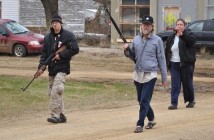In the Crosswind (2014)
Cast: Einar Hillep, Ingrid Isotamm, Laura Peterson
Director: Martti Helde
Country: Estonia
Genre: Drama | History
Editor’s Notes: The following review is part of our coverage of the 2014 Toronto International Film Festival. For more information on the festival visit http://tiff.net and follow TIFF on Twitter at @TIFF_NET.
Out of the glamour that can sometimes overwhelm film festivals, there are small films that can be overlooked. Martti Helde’s In The Crosswind (Risttuules) is a unique standout at TIFF this year.
On June 14, 1941 thousands of people from Estonia, Latvia and Lithuania were deported by the Soviets to Siberia in a Stalin ordered ethnic cleansing. Philosophy student Erna and her daughter were separated from Heldur, a soldier and Erna’s husband, in the mass deportation. Erna kept a diary where she detailed her physical and psychological hardships to Heldur without knowing if she’d ever see him again.
This is Helde’s first feature film and as a young filmmaker, this engrossing film is a courageous endeavor.
 Shot in black and white the beginning of the film traces the family’s idyllic life before their separation. The soft lens focuses on the homes setting and the forests around it. Erna’s words flow out like poetry in the narration. Once the deportations start Helde scrupulously details Erna’s diary and the experiences of the victims by utilizing a continuous series tableaux vivants. Like recreating real life photographs of on the ground scenes the camera pans in to the main focus of action, then pans back to reveal a change of action. The actors stay still with just the evidence of the wind in their hair or the slight movement of clothes revealing a moments caught in time: scores of people loaded on trains; spouses torn away from each other; horrible deaths in stark, bleak places; and many unforgettable tragedies.
Shot in black and white the beginning of the film traces the family’s idyllic life before their separation. The soft lens focuses on the homes setting and the forests around it. Erna’s words flow out like poetry in the narration. Once the deportations start Helde scrupulously details Erna’s diary and the experiences of the victims by utilizing a continuous series tableaux vivants. Like recreating real life photographs of on the ground scenes the camera pans in to the main focus of action, then pans back to reveal a change of action. The actors stay still with just the evidence of the wind in their hair or the slight movement of clothes revealing a moments caught in time: scores of people loaded on trains; spouses torn away from each other; horrible deaths in stark, bleak places; and many unforgettable tragedies.
This is Helde’s first feature film and as a young filmmaker, this engrossing film is a courageous endeavor. He keeps to various timelines within some involved scenes, in particular when Stalin’s death is announced to a room full of Soviet empathizers and prisoners. While the occasion is of many mixed emotions of hope and fear, the camera slow zoom out displays the outside world of winter where the common change of season casts an unstable tension in the air. As trains arrive and leave train stations you hear what seems like the chugging of the engine and soon realize that it’s a mixture of voice whispering the collected names of the victims. There is no stone left unturned here for Helde and Erna’s diary. Her words become a guide to this overlooked history, and also becomes a way for Helde to poetically recreate the grief and tiny triumphs the people involved felt in those situations.
It’s a great feat for Helde to direct the amount of actors he does in several of these highly involved scenes, but to keep children still for that long is an even bigger accomplishment.
Laura Peterson’s depiction of Erna is touching and subtle. While in movement she tenderly assesses the world around her and in stasis she exudes fear and mourning in her eyes. It’s a great feat for Helde to direct the amount of actors he does in several of these highly involved scenes, but to keep children still for that long is an even bigger accomplishment. It is a delicate portrayal of a time that many people still look away from and want to forget. The true strength of this film lies in its case for the fortitude of memory and personal history. Erna’s story is just one of thousands of stories within her homeland and is a testament to a million more like it that are uncovered every decade. This is why it is so crucial to make films like In The Crosswind and why they should be made well and with care for those that suffered.
Martti Helde is an interesting young talent and by tackling this extreme subject with a sensitive eye and experimental edge so well shows great promise for this filmmaker. This film is a testament that love and hope can stand the moving test of time.
Martti Helde is an interesting young talent and by tackling this extreme subject with a sensitive eye and experimental edge so well shows great promise for this filmmaker. This film is a testament that love and hope can stand the moving test of time.



